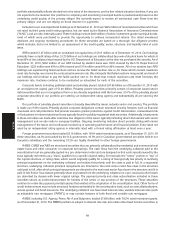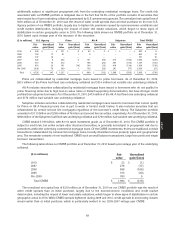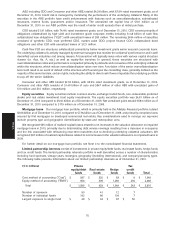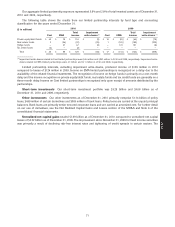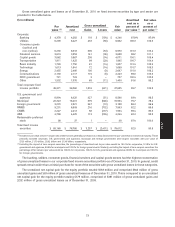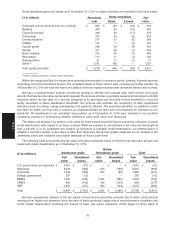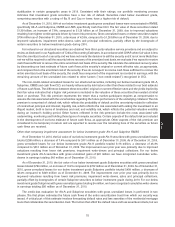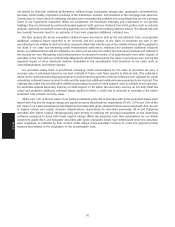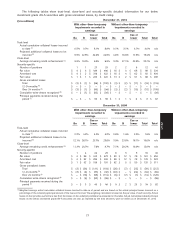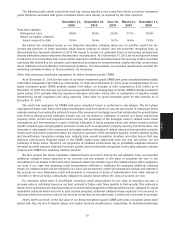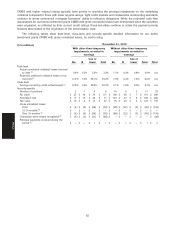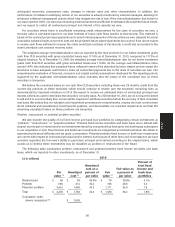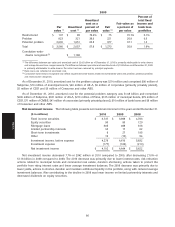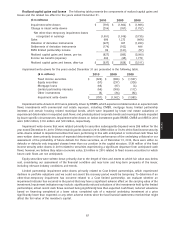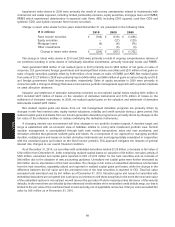Allstate 2011 Annual Report Download - page 158
Download and view the complete annual report
Please find page 158 of the 2011 Allstate annual report below. You can navigate through the pages in the report by either clicking on the pages listed below, or by using the keyword search tool below to find specific information within the annual report.
(2) Weighted average projected additional collateral losses to be incurred as of period end are based on our projections of future losses to be incurred
by the trust, taking into consideration the actual cumulative collateral losses incurred to date, as a percentage of the remaining principal amount of
the loans in the trust. Our projections are developed internally and customized to our specific holdings and are informed by and benchmarked
against credit opinions obtained from third parties, such as industry analysts, nationally recognized credit rating agencies and an RMBS loss
modeling advisory service. Projected additional collateral losses to be incurred are compared to average remaining credit enhancement for each
security. For securities where the projected additional collateral losses exceed remaining credit enhancement, a recovery value is calculated to
determine whether impairment losses should be recorded in earnings. The weighting calculation is based on the par value of each security.
(3) Weighted average remaining credit enhancement as of period end is based on structural subordination and the expected impact of other structural
features existing in the securitization trust beneficial to our class and reflects our projection of future principal losses that can occur as a
percentage of the remaining principal amount of the loans in the trust before the class of the security we own will incur its first dollar of principal
loss. The weighting calculation is based on the par value of each security.
(4) Includes total gross unrealized losses on securities in an unrealized loss position for a period of 12 to 24 consecutive months.
(5) Includes total gross unrealized losses on securities in an unrealized loss position for a period more than 24 consecutive months. As of December 31,
2010, $70 million of unrealized losses on securities with other-than-temporary impairments recognized in earnings and $11 million of unrealized
losses on securities without other-than-temporary impairments recognized in earnings have been greater than or equal to 20% of those securities’
amortized cost for a period of more than 24 consecutive months. As of December 31, 2009, there were no Alt-A securities with gross unrealized
losses greater than or equal to 20% for a period of more than 24 consecutive months.
(6) Includes cumulative write-downs recorded in accordance with GAAP.
(7) Reflects principal payments for the years ended December 31, 2010 and 2009, respectively.
The above tables include information about our below investment grade Alt-A securities with gross unrealized
losses as of each period presented. The par value and composition of securities included can vary significantly from
period to period due to changes in variables such as credit ratings, principal payments, sales, purchases and realized
principal losses.
As of December 31, 2010, our below investment grade Alt-A securities with gross unrealized losses and without
other-than-temporary impairments recorded in earnings had incurred actual cumulative collateral losses of 3.0%. Our
impairment evaluation forecasts more severe assumptions than the trusts are actually experiencing, including a
projected weighted average underlying default rate of 33.7% and a projected weighted average loss severity of 47.4%,
which resulted in projected additional collateral losses of 15.4%. As the average remaining credit enhancement for
these securities of 20.7% exceeds the projected additional collateral losses of 15.4%, these securities have not been
impaired.
As of December 31, 2010, our below investment grade Alt-A securities with gross unrealized losses and with
other-than-temporary impairments recorded in earnings had incurred actual cumulative collateral losses of 8.0%. Our
impairment evaluation forecasts more severe assumptions than the trusts are actually experiencing, including a
projected weighted average underlying default rate of 43.5% and a projected weighted average loss severity of 55.3%,
which resulted in projected additional collateral losses of 24.5%. As the average remaining credit enhancement for
these securities of 6.9% is insufficient to withstand the projected additional collateral losses, we have recognized
cumulative write-downs in earnings on these securities as reflected in the table above using our calculated recovery
value at the time of impairment. The current average recovery value of these securities as a percentage of par was 74.0%
and exceeded these securities’ current average amortized cost as a percentage of par of 72.1%, which demonstrates our
conclusion that the nature of the remaining unrealized loss on these securities is temporary and will reverse over time.
The comparison indicates that recovery value exceeds amortized cost based on a comprehensive evaluation of financial,
economic and capital markets assumptions developed for this reporting period.
The following table shows actual trust-level key metrics specific to the trusts from which our below investment
grade Alt-A securities with gross unrealized losses were issued, as reported by the trust servicers.
December 31, September 30, June 30, March 31, December 31,
2010 2010 2010 2010 2009
Trust-level statistics
Delinquency rates 29.4% 28.0% 27.9% 28.1% 25.9%
Actual cumulative collateral
losses incurred to date 7.2% 6.5% 5.5% 4.3% 3.5%
We believe the unrealized losses on our Alt-A securities, including those over 24 months, result from the current
risk premium on these securities, which should continue to reverse over the securities’ remaining lives, as demonstrated
by improved valuations in 2010. We expect to receive our estimated share of contractual principal and interest
collections used to determine the securities’ recovery value. As of December 31, 2010, we do not have the intent to sell
and it is not more likely than not we will be required to sell these securities before the recovery of their amortized cost
basis. We believe that our valuation and impairment processes are comprehensive, employ the most current views about
78
MD&A


